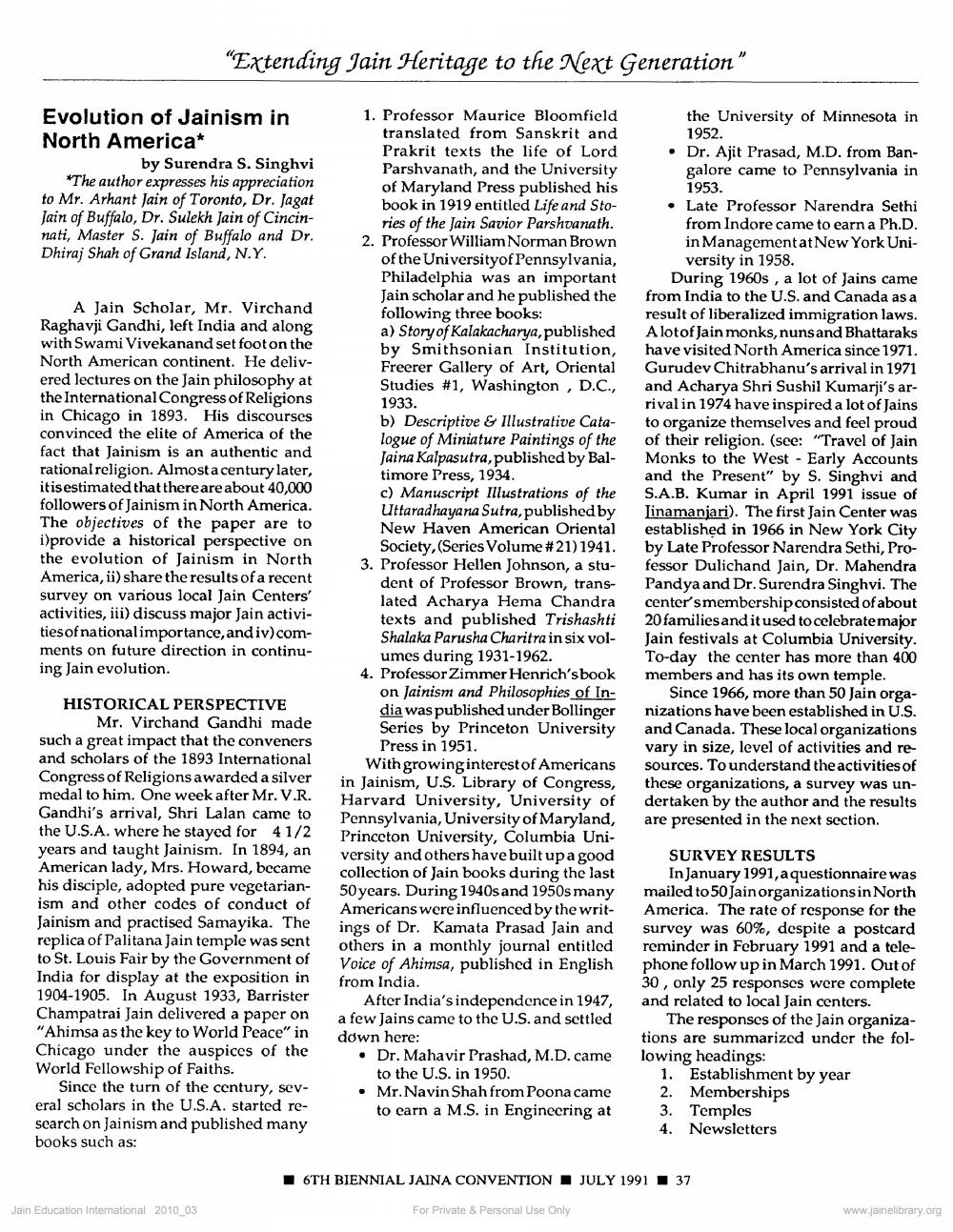________________
"Extending Jain Heritage to the Next Generation"
Evolution of Jainism in North America*
by Surendra S. Singhvi *The author expresses his appreciation to Mr. Arhant Jain of Toronto, Dr. Jagat Jain of Buffalo, Dr. Sulekh Jain of Cincinnati, Master S. Jain of Buffalo and Dr. Dhiraj Shah of Grand Island, N.Y.
A Jain Scholar, Mr. Virchand Raghavji Gandhi, left India and along with Swami Vivekanand set foot on the North American continent. He delivered lectures on the Jain philosophy at the International Congress of Religions in Chicago in 1893. His discourses convinced the elite of America of the fact that Jainism is an authentic and rational religion. Almost a century later, itis estimated that there are about 40,000 followers of Jainism in North America. The objectives of the paper are to i)provide a historical perspective on the evolution of Jainism in North America, ii) share the results of a recent survey on various local Jain Centers' activities, iii) discuss major Jain activities of nationalimportance, and iv) comments on future direction in continuing Jain evolution.
1. Professor Maurice Bloomfield
translated from Sanskrit and Prakrit texts the life of Lord Parshvanath, and the University of Maryland Press published his book in 1919 entitled Life and Sto
ries of the Jain Savior Parshvanath. 2. Professor William Norman Brown
of the Universityof Pennsylvania, Philadelphia was an important Jain scholar and he published the following three books: a) Story of Kalakacharya, published by Smithsonian Institution, Freerer Gallery of Art, Oriental Studies #1, Washington, D.C., 1933. b) Descriptive & Illustrative Catalogue of Miniature Paintings of the Jaina Kalpasutra, published by Baltimore Press, 1934. c) Manuscript Illustrations of the Uttaradhayana Sutra, published by New Haven American Oriental
Society, (Series Volume #21) 1941. 3. Professor Hellen Johnson, a stu
dent of Professor Brown, translated Acharya Hema Chandra texts and published Trishashti Shalaka Parusha Charitra in six vol
umes during 1931-1962. 4. Professor Zimmer Henrich's book
on Jainism and Philosophies of India was published under Bollinger Series by Princeton University
Press in 1951. With growinginterest of Americans in Jainism, U.S. Library of Congress, Harvard University, University of Pennsylvania, University of Maryland, Princeton University, Columbia University and others have built up a good collection of Jain books during the last 50 years. During 1940s and 1950s many Americans were influenced by the writ- ings of Dr. Kamata Prasad Jain and others in a monthly journal entitled Voice of Ahimsa, published in English from India.
After India's independence in 1947, a few Jains came to the U.S. and settled down here: • Dr. Mahavir Prashad, M.D. came
to the U.S. in 1950. • Mr.Navin Shah from Poona came
to earn a M.S. in Engineering at
the University of Minnesota in 1952. Dr. Ajit Prasad, M.D. from Bangalore came to Pennsylvania in
1953. • Late Professor Narendra Sethi
from Indore came to earn a Ph.D. in Management at New York Uni
versity in 1958. During 1960s, a lot of Jains came from India to the U.S. and Canada as a result of liberalized immigration laws. A lotof Jain monks, nuns and Bhattaraks have visited North America since 1971. Gurudev Chitrabhanu's arrival in 1971 and Acharya Shri Sushil Kumarji's arrival in 1974 have inspired a lot of Jains to organize themselves and feel proud of their religion. (see: "Travel of Jain Monks to the West - Early Accounts and the Present" by S. Singhvi and S.A.B. Kumar in April 1991 issue of Jinamanjari). The first Jain Center was established in 1966 in New York City by Late Professor Narendra Sethi, Professor Dulichand Jain, Dr. Mahendra Pandya and Dr. Surendra Singhvi. The center's membership consisted of about 20 families and it used to celebrate major Jain festivals at Columbia University. To-day the center has more than 400 members and has its own temple.
Since 1966, more than 50 Jain organizations have been established in U.S. and Canada. These local organizations vary in size, level of activities and resources. To understand the activities of these organizations, a survey was undertaken by the author and the results are presented in the next section.
HISTORICAL PERSPECTIVE
Mr. Virchand Gandhi made such a great impact that the conveners and scholars of the 1893 International Congress of Religions awarded a silver medal to him. One week after Mr. V.R. Gandhi's arrival, Shri Lalan came to the U.S.A. where he stayed for 41/2 years and taught Jainism. In 1894, an American lady, Mrs. Howard, became his disciple, adopted pure vegetarianism and other codes of conduct of Jainism and practised Samayika. The replica of Palitana Jain temple was sent to St. Louis Fair by the Government of India for display at the exposition in 1904-1905. In August 1933, Barrister Champatrai Jain delivered a paper on "Ahimsa as the key to World Peace" in Chicago under the auspices of the World Fellowship of Faiths.
Since the turn of the century, several scholars in the U.S.A. started rescarch on Jainism and published many books such as:
SURVEY RESULTS
In January 1991, a questionnaire was mailed to 50 Jain organizations in North America. The rate of response for the survey was 60%, despite a postcard reminder in February 1991 and a telephone follow up in March 1991. Out of 30, only 25 responses were complete and related to local Jain centers.
The responses of the Jain organizations are summarized under the following headings:
1. Establishment by year 2. Memberships 3. Temples 4. Newsletters
6TH BIENNIAL JAINA CONVENTION
JULY 1991
37
Jain Education Interational 2010_03
For Private & Personal Use Only
www.jainelibrary.org




